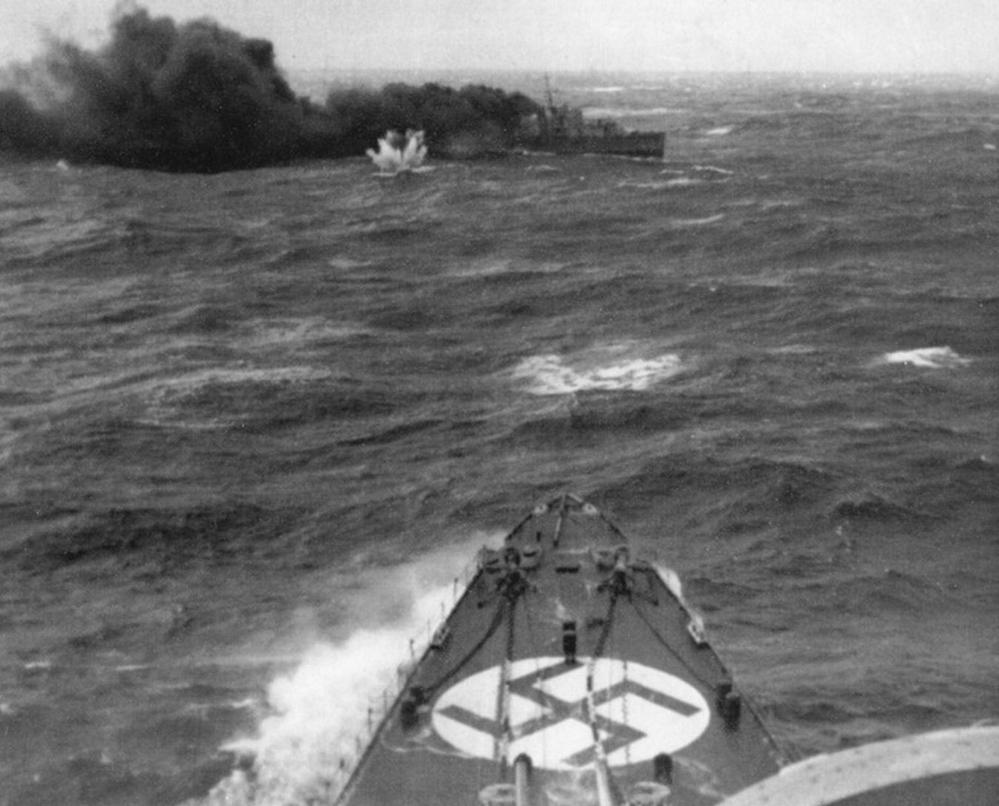Image: Glowworm Prepares to Ram June 26, 2015
Author: Beach Combing | in : Contemporary , trackbackThe chance event that led to this extraordinary WW2 picture was a sailor, an ableseaman Ricky, being washed overboard in heavy seas from his ship HMS Glowworm. Glowworm under its captain Gerard Roope had been, 5 April 1940, one of four destroyer escorts of HMS Renown rallying out from Scapa Flow to prevent Hitler’s invasion of Norway. 6 April Glowworm had left the squadron to look for Ricky, who had disappeared into the ocean, during the night. It was to prove a fatal mistake…
Not only did Glowworm not find Ricky, while trying to rejoin Renown (and after another man had gone overboard), she ran into two German destroyers, the Von Arnim and the Jakoby, and promptly engaged: Roope conformed to the typical WW2 model of British ‘tiger’ captains. The German destroyers were full of invasion troops for Norway and, in incredibly rough seas, seven men were washed off the German vessels as they turned away from the British attack. Von Arnim and Jakoby fled, hoping to lead the British destroyer towards one of their big brothers, and HMS Glowworm took the bait.
Roope, in fact, ran through a squall and emerged the other side to find himself face to face with a heavy German cruiser the Admiral Hipper under Captain Hellmuth Heye: Roope thought initially that the Hipper might have been a British ship but his recognition signals (‘a a a a’) were met by shells. Firing began at 0959 and the German giant, ten times the size of its British adversary, pounded the Glowworm. The battle lasted twenty-six terrifying minutes until the Glowworm’s boilers exploded. In that time the Glowworm’s crew managed to get all of her ten torpedoes in the water, a number missing the Hipper by mere yards. The Glowworm was now out of options and rammed the German cruiser: sitting in the water after this desperate act one British gunner continued shooting on the enemy till the order to abandon ship was given by Roope.
The Germans managed to pull forty of the British crew out of the water and onto their decks: 31 from the crew of 149 would survive. Roope, though, was not among them, he had got to the German ropes but had been washed off by an enormous wave. (His last recorded conversation was about how he wouldn’t be playing cricket for a while…) He was awarded a Victoria Cross, the first of the war chronologically: it was given, however, only in 1945 when the survivors of Glowworm were brought back to Britain and testimonies could be checked. The award depended in part on a written recommendation from Heye who had sent a report to the British authorities through the Red Cross paying tribute to his dead adversary: reminiscent of Tovey’s tribute to the commanders of the Bismarck.
There are several questions about the attack that have never been entirely resolved. Did the Glowworm ram the Hipper on the orders of Roope as one survivor claims (this is the preferred narrative)? Was it another crew member directing the ship? Or was it just the Glowworm itself taking on a life of its own as its steering instruments ceased to function? (A pointless aside: Roope was known by his men as ‘Rammer Roope’ because of a pre-war accident.) Another question is whether the sacrifice of Glowworm was necessary. Roope should perhaps, it has been suggested, have decided that discretion was the better part of valour and run for the horizon: not something it has to be said that Royal Navy captains routinely did in the last war. Instead, he chose a fight that he must have known would end in his ship’s destruction, hoping against hope that a torpedo would find the Hipper’s side and that the sacrifice of his ship would not be in vain.
The picture that heads the post was clearly taken from on board the Hipper. It was given to one of the survivors Bert Harris, by a German soldier and Bert kept it safe for many years before allowing it to be published. It is one of the most remarkable photographs from the war at sea and shows Glowworm running hard under smoke in her deadly dance. At this time most of the British crew were still alive, minutes later the vast majority would be dead.
One other haunting detail: the Glowworm’s siren had jammed in the early part of the attack and it was giving off what has been described as a permanent ‘banshee’ wail for the last minutes of its existence.
Anyone interested in HMS Glowworm there is a wonderful site.
Other ‘action’ pictures from sea battles? drbeachcombing At yahoo DOT com
30 June 2015: James K. writes in: ‘What is the difference in the end between the acts of the Glowworm and a Japanese kamikaze and other similar reckless acts in the Royal Navy in the war. Consider the story of the Rawalpindi: the Rawalpindi was a merchant seaman that was destroyed hopelessly even though German ships gave it a chance to surrender. At least the Kamikaze and the Glowworm had a chance to do some damage first…’



